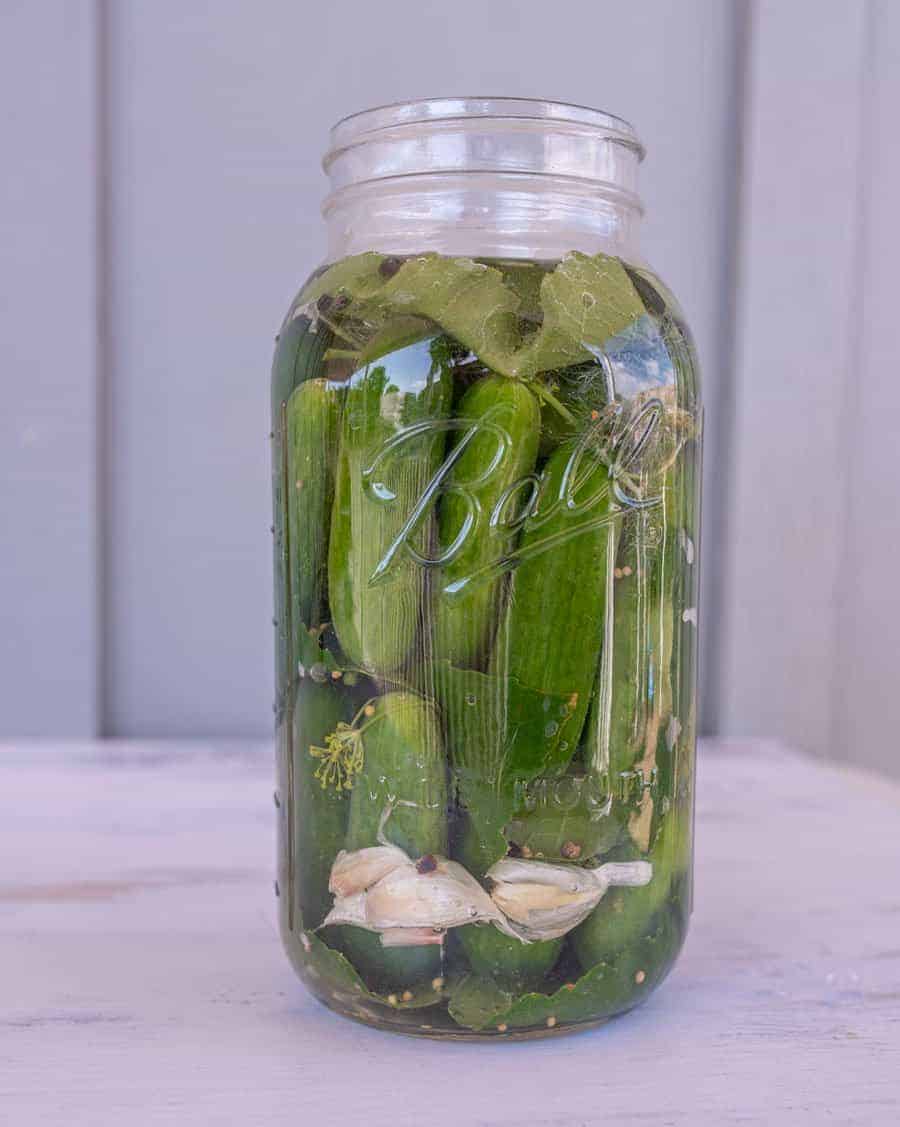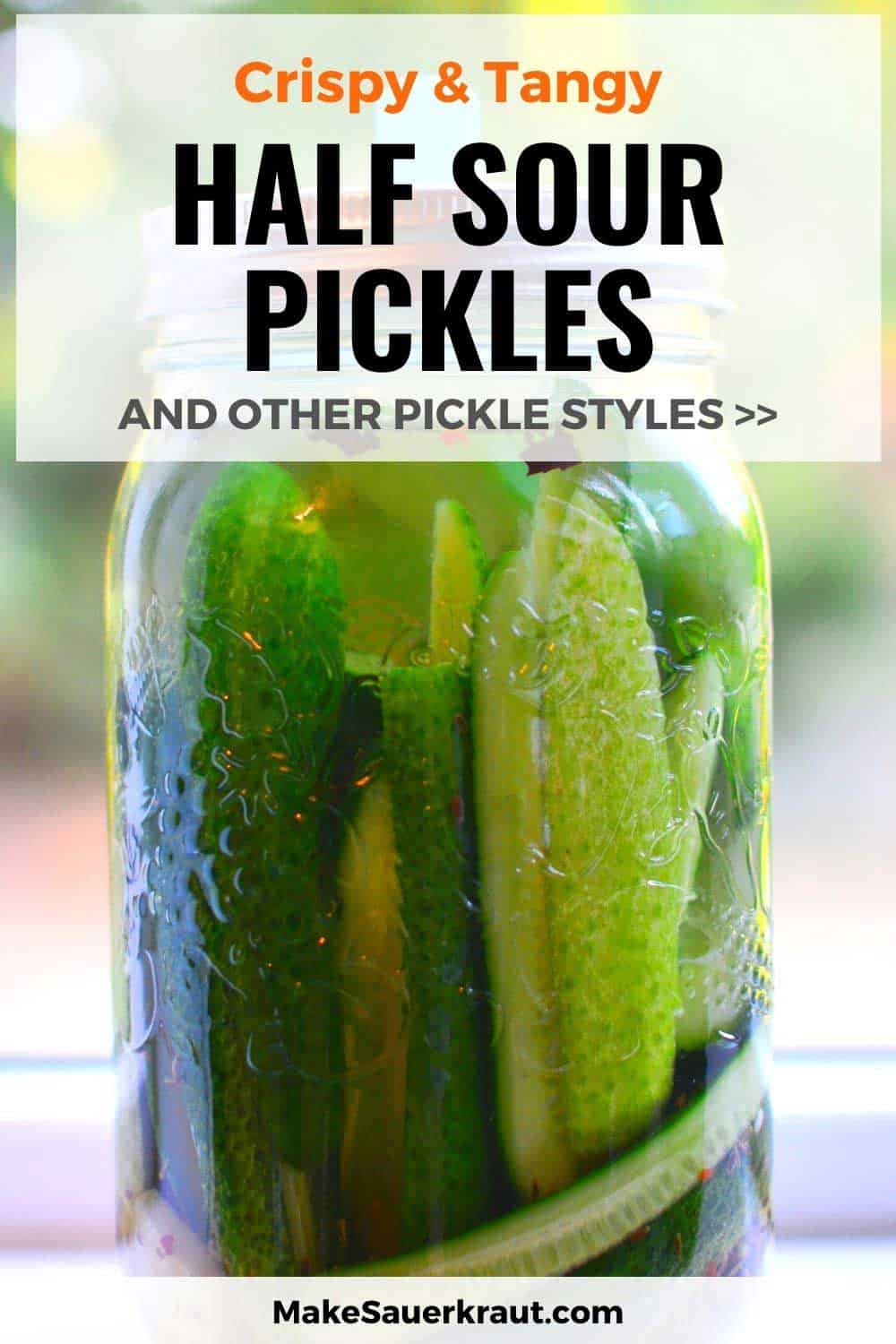Since summer is the main season for growing cucumbers we were required to work 6 to 7 days a week, so really every day of the summer. When i came back the following summer i was immediately promoted to working in the lab testing batches of pickles, sauerkraut, eggs (pickling eggs is the smelliest thing), and anything else we pickled that day.
 My impression of preserving
food
was based on using vinegar and salt. Now since reading real food fermentation , i know that salt and whey can be used to create a probiotic rich food in a few days.
My impression of preserving
food
was based on using vinegar and salt. Now since reading real food fermentation , i know that salt and whey can be used to create a probiotic rich food in a few days.
Homemade Pickles with Garlic and Dill
Clean the cucumbers well and let them soak in cold water with the ice cubes for 4 to 8 hours. This step will help them stay crunchy until after fermentation. Prepare the brine by dissolving the salt and sugar in the water. Stack the pickles, whole or sliced (depending on your family traditions), in the jars. Divide the grape leaves (if using), the garlic cloves, dill sprigs, pepper, caraway and cumin between the two jars. Cover with sweet brine (with 4% salt). Close the jars and place an airlock. Otherwise, completely close the lid, but release the pressure once a day for the first 3 days: slightly unscrew the adjustment ring for a few seconds, then close tightly.

This recipe is for one 32 ounce jar of pickles. Fit as many cucumbers into the jar as you can while making sure they do not go above the rim. The cucumbers need to be fully submerged. Double or triple the recipe, depending on how many cucumbers you have to pickle. Remember that it’s very important to keep all cucumbers submerged at all times. Ingredients: 2-1/2 tablespoons sea salt 32 ounces filtered water (it needs to be filtered. Chlorine will kill the fermentation process) 3 garlic cloves, sliced 1 spring fresh dill, or 1 tablespoon dried dill 1 teaspoon whole peppercorns 2 grape leaves (oak or horseradish leaves are a substitute).
You can make all kinds of different pickle spice combinations when you make small batches of fermented pickles. You can add garlic, dill weed, dill seed, peppercorns, mustard seed, whole cloves, whole allspice, and even onion slices. You can also use this pickling spice recipe to make a batch and have it ready so you don’t have to open a bunch of jars every time you want to make fermented pickles. Just keep notes of what you put in each jar so you can recreate the ones you liked best.
There are two main ways to make pickles yourself. One way is to brine them in vinegar. The other way is to ferment the cucumbers with just salt and water. No matter the method you use, follow these general tips: pick cucumbers that are fresh, firm, and damage-free. Use canning or pickling salt. Other salts cloud up the brine. Add dill seed, horseradish, mustard seed, garlic, and any other spices. Follow boiling and canning instructions carefully to prevent bad bacteria from growing inside. Keep pickles in sealed jars for several weeks before you eat them.
How salt works in fermentation:
The lacto-fermentation process works because of the lucky fact that bacteria that could be harmful to us can't tolerate much salt , while healthy bacteria (think yogurt) can. Think of them as the bad guys vs. The good guys. Lacto-fermentation wipes out the bad guys in its first stage, then lets the good guys get to work during stage two. In stage one of lacto-fermentation, vegetables are submerged in a brine that is salty enough to kill off harmful bacteria. The lactobacillus good guys survive this stage and begin stage two. In stage two of lacto-fermentation, the lactobacillus organisms begin converting lactose and other sugars present in the food into lactic acid.
Fermented Pickles Recipe: How to Make Crunchy Brined Cucumber Pickles
If you ever enjoyed a salt beef bagel from an old-school jewish deli, then you’re no stranger to traditional kosher dill pickles. You can easily create your own traditional homemade fermented cucumber pickles that are just as crunchy, tangy, and delicious. We will use the original lacto-fermentation method to make these classic lacto-fermented cucumber pickles, which are far tastier and healthier than store-bought dill pickles. These deli-style cucumber pickles are full of gut-healthy probiotics, and you can control how tangy or mild you want it. This recipe can be used to make half-sour pickles or full-sour pickles.
What are fermented pickles?
What’s truly amazing is that so many people love pickles even if they’ve never tasted a really good one. A great pickle makes your eyes widen in surprise and your tongue tingle with pleasure. The sourness should make you salivate for more, rather than pucker and wince, and the texture should have a noticeable crunch when bitten into. Read more: naturally fermented pickles mark sisson, mark's daily apple practice with a few small batches in jars before fermenting in a large crock. It is much easier to stomach losing the costs of a small jar of moldy pickles than it is a large crock.
When making lacto fermented pickles, use only the freshest cucumbers that were picked that day, if possible. If you must wait, keep them well sealed in a plastic bag in the coldest part of your fridge for no more than a day or two. Only very firm, crisp cucumbers can deliver that crunchy, sour bite you’re looking forward to as you read this. Lacto fermentation and old, seedy produce do not go well no matter what you ferment. This includes any added herbs. If you use produce that is past its prime, they can sometimes discolor your ferment, particularly on the top surface.
This year i planted 2 cucumber plants in my straw bale garden and they have grown wild. I'm picking 8 to 15 every other day! since i have been having so many cucumbers i decided to make lacto fermented pickles with them! i decided on lacto fermented pickles (also known as half-sour) instead of the traditional boiled vinegar variety because lacto fermentation has many health benefits that traditional pickles just don't have. At first, i just made a recipe i found online but they had a super strong taste and no one liked them 🙁 i wanted a recipe that tasted like the traditional pickles we all know and love - just using a different method!.
Similar to the way we make fermented sauerkraut , i use a variety of vessels for my fermenting. For making crock pickles, i used a lovely handmade crock i found at a yard sale earlier in the summer. This crock fit just under a dozen small pickling cucumbers that we fermented whole. You can also use a glass jar with one of these snazzy fermenting lids.

No comments:
Post a Comment